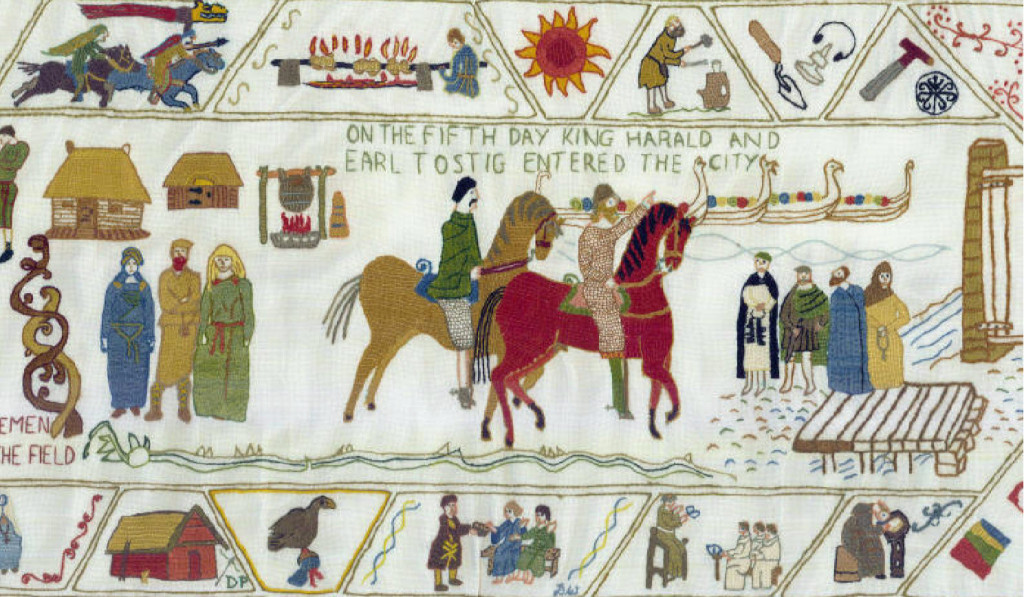The Fulford Tapestry
There are two years in history that changed the destiny of the western world. One is 1944, when the the Allied Forces crossed the Channel to the coasts of Normandy and the other is 1066 when the Saxon armies fought the invasion by the Duke of Normandy at the Battle of Hastings. There were two other battles in England prior to this and both are commemorated with large embroideries But first, here is a brief account of why 1066 was such a pivotal year.

The Bayeux Tapestry, Scene 1: King Edward the Confessor and Earl Harold Godwinson
In January 1066, King Edward the Confessor died without a direct heir but leaving three contenders to the throne of Saxon England. The first was Earl Harold Godwinson, Edward’s brother in law, a competent statesman and army general who had been running the country for Edward for years. The second was King Hadradra of Norway. The third was Duke William of Normandy. As England was a prosperous farming country at the time, it was a desirable acquisition.
King Hadrada was a Viking and a fierce and experienced warrior. The Vikings had a long history of marauding, pillaging and plundering. In 1066 they were well equipped with about 7000 men and 300 longships. In mid September, they landed on the eastern shores of England near Scarborough, which they burned, and then moved on to the city of York. Earl Tostig, Harold Godwinson’s estranged brother, joined the Viking forces bringing more men. Tostig hoped to claim Northumbria as his own domain. Their combined forces were around 10,000 fighting men though the number varties depending on the source. The English army was about half the size.

What ensued on September 20 was the first battle of 1066, the Battle of Fulford Gate, which was won by the Vikings. It was a fierce encounter with heavy losses on both sides. Hadrada is the lone figure on the right hand side with his sword above his head. Their prize was the City of York which the Vikings agreed not to pillage or burn. The Saxons also agreed to join the Vikings on their trek south to London where King Hadrada planned to claim the throne of England.

In the panel below, King Hadrada, with blond hair and beard, followed by Tostig as shown entering the city of York.

The embroidery, like the Bayeaux Tapestry, is a continuous strip of fabric about 18 feet long. The upper and lower friezes contain scenes from everyday life. It was designed by Charles Jones and stitched by local embroiderers who dyed their wool threads using tradional methods. The continuous strip is divided into six sections for photography of which three are included here,
The Fulford Tapestry was completed about seven years ago. I have read as much as I can find about the Battle of Fulford Gate and have condensed it to a few sentences which may, or may not, give you an accurate picture. I apologize for errors. You can read more about this important day on the sites listed.
The final photo is of the ladies who stitched on the Fulford Tapestry.

http://www.britainexpress.com/History/battles/Fulford.htm
http://www.fulfordtapestry.info
The creation of the Fulford Tapestry – Images
Fascinating history…thanks for the condensed info. The needlework is fascinating and I’m wondering if we would know as much if the Bayeaux tapestry had not preserved that history for us.